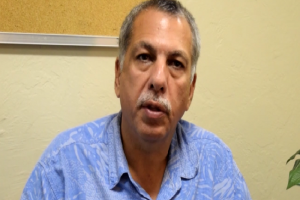Dengue: County-Level Emergency Proclamation May be ‘Close’
Two new cases of dengue fever on the Big Island were confirmed Tuesday, bringing the total count of individuals who contracted the disease since September to 246. In addition, three individuals are being listed by DOH as “potentially infectious.”
During a Tuesday news conference, Governor David Ige addressed the topic of an emergency declaration for the Big Island’s dengue outbreak. The topic was initially brought to the forefront of public talk when Representative Tulsi Gabbard called on Governor Ige last Friday to declare an emergency amid the continued spread of the dengue disease on the Big Island.
Governor Ige defended his current stance, noting that a proclamation draft had been completed in November, and that the decision to officially declare such an emergency was not yet needed as he conferred with local officials.
“It’s something that we discuss early on in any event. A first draft of a proclamation was done in November, and there is continuous conversation about it,” Governor Ige said. “As we proceed through an event and identify what points of action are required, then we make that assessment, and there have been conversations about whether it is appropriate or needed or not.”
Darryl Oliveira, Hawai’i County Civil Defense administrator and incident commander in the outbreak, noted that the need for an emergency proclamation had not been urgent, however, at a county level, an emergency proclamation is close.
“We’re very close to making, at least on the county level, a proclamation…It’s not because we don’t have control over the situation or any shortage of resources currently. We’d like to stay ahead of the response,” said Oliveira.
Under an emergency declaration, additional resources would be made available. This would provide support to efforts currently being conducted on the island and aid in response, should dengue spread to other areas.
Maui has had at least one confirmed case of dengue fever in the past month. DOH officials have said the case involved an individual who traveled out of the country and that the case is not linked to the Big Island outbreak.
Talk of potential cases on Maui, however, has heightened the awareness of government officials, and with sprayers and resources focused on the Big Island’s outbreak, another incident in the state could pose a threat to potential dengue response operations.
In total, 220 Big Island residents have been impacted by dengue since the outbreak began. Twenty-four of the total cases have been in visitors to the island.
Along with the confirmed cases, 1,059 cases have been excluded from the count as a result of negative test results and/or not meeting case criteria.
On Thursday, Feb. 4, a community meeting regarding the outbreak will take place at Pu’uhonua o Honaunau National Historical Park’s Amphitheater.
The community update will be held from 6 p.m. to 7:30 p.m. and will include presentations by the Office of Hawai’i County Mayor Billy Kenoi, Hawai’i County Civil Defense, Hawai’i Department of Health, Centers for Disease Control and Prevention, United States Geological Survey, and National Park Service.
Community meetings are being held through the month of February on a weekly basis in both East and West Hawai’i.
Hilo sessions take place on Thursdays at 11:30 a.m. at the State Office Building, located on Aupuni Street. Kona sessions are held at the same time, but at the West Hawai’i Civic Center, Mayor’s Conference Room.
Tuesday sessions are being held at Yano Hall in Captain Cook, beginning at 12:30 p.m.
The community meetings provide updates and answers to questions from the community about the dengue fever outbreak on the Big Island, as well as education about the prevalence, transmission, and symptoms of dengue fever, along with outbreak response efforts, how to interpret case counts and maps, and the best ways to “Fight the Bite.”
Symptoms of dengue fever include fever, joint or muscle pain, headache or pain behind the eyes, and rash.
Those interested in obtaining general information about the current Big Island dengue fever investigation should call 2-1-1 and talk with Aloha United Way.
Anyone who thinks they may have contracted dengue fever on the Big Island should call 933-0912 if they are located in East Hawai‘i or 322-4877 in West Hawai‘i. If an individual is currently ill and concerned that they may have contracted dengue fever, they should contact their primary care physician.
Civil Defense suggests the following to aid in reducing potential mosquito breeding areas around homes and businesses:
- Remove or eliminate standing water that provides sources for mosquito breeding such as buckets or puddles.
- Fix leaky faucets and outdoor hoses that are dripping water.
- Treat bromeliads and other plants that hold water with a larvacide or chlorine bleach solution.
- Clean gutters to allow water to drain freely.
- Repair screens and windows to help keep mosquitoes out.
- Dispose of old tires at no charge at county transfer stations islandwide.
Mosquito concerns should be reported to 974-6010 in East Hawai‘i or 322-1513 in West Hawai‘i.















